
What is the creative process anyway?
Coming up with ideas can seem mysterious and ephemeral. Yet, process is more natural than you think.
The established methods can be different for everyone. When working with creatives in a professional setting the process becomes the tool for navigating how to consistently innovate at scale. Yet for many, it still remains hard to define, hard to measure and hard to explain how to come up with creative solutions.
This uncertainty manifests in the overuse of the term.
“What’s the process?”
“They aren’t following process”
“Their process doesn’t align with ours.”
“I have my own process”
Almost no creative person maps out the steps every time they set out to create. However, intuitively, each creative has a process whether they’ve formalized it or not. Every creative person goes about generating ideas in an individualistic way — their process is uniquely their own. As they grow their craft, these processes formalize and become the basis to arrive at ideas faster, better, and easier.
As people seek to create a practice and develop creative skills, how we look at the process and practice of creativity becomes crucial. How do we define what process means in a creative context? No matter how regimented or unconstrained you may approach the work, creativity and process go hand in hand.
Creativity and process are inextricably linked
In the simplest terms, creativity is the “phenomenon whereby something new and somehow valuable is formed”. It’s particularly simple and not tied to any medium whereby it can take on any form — from art to scientific theories. This way of defining creativity is a relatively modern definition considering how innately human creativity feels.
Thinkers in Ancient Greece, China and India didn’t view creativity as we do today. Creativity was the act of making. Art, from an ancient perspective, was a form of discovery, not creation. For example, in The Republic Plato mentions that a painter is not a maker, but someone who merely imitates. When we look at the way language expresses the perspectives of a certain time, the Latin term for creativity, creare, is linked to divinity. Like the muses of Greek myth, creativity at that time in history is viewed as an outside force.
It wasn’t until the 18th and 19th centuries where creativity was understood as a uniquely human experience. The study of imagination had become more frequent. As thinkers began to understand imagination, they found that it was a key element of human cognition. A fundamental part of how our brain operates. By the early 20th century, scientists were looking at the ways in which creativity manifests in our brains.
To understand what is creativity is to understand the ways in which the brain forms new ideas.
Process is not a procedure, but the innate way of arriving at ideas.
As a creative operations leader, defining the process is at the core of what I do. To creative people, however, rules and methods can feel too rigid. The freedom to explore is a characteristic that is foundational to many. Setting too many boundaries or rules can stifle exploration and divergent thinking necessary for new ideas.
Processes are the steps in which our brains arrive at novel ideas.
While procedures might appear to be too rigid, there is are observable steps our brains naturally take to arrive at novel solutions. The earliest model of the creative process described the steps in 5 stages — the 5 ‘tions’ as I like to call them.
The five stages of the cognitive creative process
Preparation
This sounds relatively straightforward — preparation is the act of getting ready to come up with ideas. Yet, preparing to have an idea can seem complicated. How do you prepare for something that hasn’t happened yet and when you don’t have the solution? The answer is to define the problem you’re looking to solve and, interestingly, to have the intent to solve it.
In a business setting, preparation can take the form of a brief. The brief is the document that defines the problem you’re looking to solve and provides additional context around the problem. Context in culture or in the world.
In individual settings, preparation can take the form of curiosity and uncovering the subject you’d like to focus on. It can start with an observation that then drives curiosity and defining what it is that is taking your focus. Defining the parameters and dimensions of the problem.
Incubation
Ever notice how after days or weeks of trying to find a solution when you go to sleep you find the solution in your sleep? Or when you’re working on an assignment, and perhaps you’ve completed the task, but yet after a few days, you’ve realized a better way? These moments might feel like they come out of nowhere, but in fact, it is the natural course for creativity.
Incubation is where the brain is internalizing the problem. You might not sense that anything is happening, yet your brain is doing a lot of the heavy lifting and processing during this stage. The time between getting the brief and when ideas become conscious to you is the incubation stage.
Intimation
The best way I can explain the intimation stage is when something is on the tip of your tongue. That feeling when you’re on the brink of something that at any moment the solution will pour out of you. That is intimation; when a solution is becoming known to you in an indirect way.
Illumination
This is the moment when the idea hits us — the a-ha moment. Our brains have spent all this time doing a lot of the background work. It has processed the problem, the context around it and made new connections. When illumination or insight takes form, it can seem like it comes at us all of a sudden. Make no mistake though, the steps that led up to this moment take a great deal of effort on the part of our brains, and the more information we provide our minds, the richer or insightful the idea.
Verification
You may think that all the hard work is over, however, there is one last step to the creative process. After we’ve had the idea come to mind, we must go through the steps to verify that it will work and that it is valid. Then, we elaborate on the idea. It takes form and expands on it. Lastly, we’ll apply the idea in its intended form — a theory, a painting, a song, an app, etc.
When working in creative teams, the critique is also a part of this stage. The idea would have gone through an initial stage of verification by creating mockups or drafts of the idea. Then showing them to your colleagues helps further verification. Critiques answer whether you’re on the right track and point out further exploration to consider. It also leverages the further processing power of other minds. Starting this process all over again to arrive at an improved iteration.
Creativity is a natural cognitive process
The beauty of these steps is that majority happen in the background, our brain is doing all the work behind the scenes which is why ideas can strike us at any time. It also provides good insight as to the reason many of us think creativity is reserved for ‘creative people’. When this type of thinking happens sub-consciously it is easy to understand how it can appear as mysterious. Make no mistake though, creativity is in all of us.
For those that think of this as a p-word, process provides a map and guidance on how to create the conditions for creativity. In a business, a defined creative process sets the stage to repeat this phenomenon with as little friction as possible. With enough practice, creativity can be honed for improved innovation — for culture and for the future.

